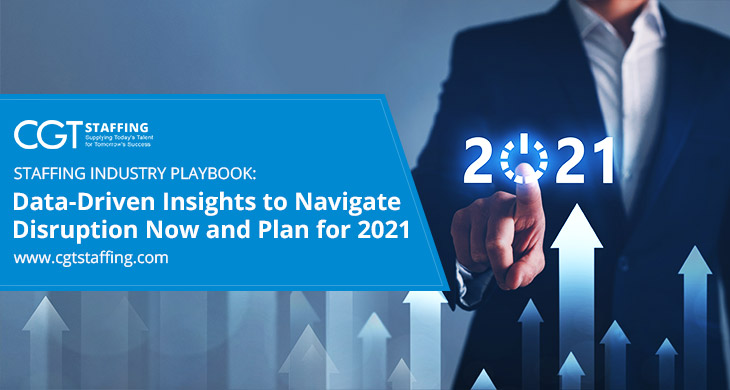The business world has changed immensely over the past year. The COVID-19 pandemic has disrupted economies on an unprecedented scale. The global economy has seen a massive recession. In the US alone, millions of Americans have had to claim unemployment benefits as businesses shut down (whether temporarily or permanently). The healthcare implications of the COVID-19 pandemic are staggering enough, but its impact on the business world is equally significant. One of the areas of business that has seen acutely disruptive trends is recruitment.
Some of these trends were already progressing before COVID-19 and were only accelerated by the pandemic. Others are the direct result of the pandemic itself. This blog explores how businesses and recruiters can manage these new disruptions and adapt to them. Read on for more information.
Table of Contents
Pandemic and Businesses in 2020
It is remarkable how the pandemic has affected different organizations in different ways. The travel, hospitality, and tourism industry are by far some of the hardest hit. Accordingly, many businesses in those industries are re-examining their business models. In the United States alone, the pandemic has taken its toll on several states such as Hawaii, Florida, and Nevada. The UN estimates a $1 trillion loss to global tourism, along with over 100 million workers facing the risk of losing their jobs.
However, other industries, particularly digital communications, IT services, and online retail have seen rapid growth beyond what anyone could have expected. Depending on how the organization was impacted, various firms are restructuring their operations to cut costs and create a leaner, sustainable operation. Other firms are investing in expansion to cater to the increased demand for their products or services.
The Impact on Hiring and the Job Market
The pandemic has cost 1 in every 6 Americans their jobs. The contrast between expanding and restructuring has resulted in significantly different talent strategies. Certain employers have had to furlough or even lay off significant parts of their workforce. Now many of them are still hiring for essential positions, but with caution. After all, the future is fraught with uncertainty.
Employers want to be sure they have a sustainable capacity for new workers. From the in-house recruiter to local staffing agencies, this means the hiring process is now under close scrutiny. Every decision to hire or not hire is made with a lot of deliberation and thought.
However, on the flip side employers face massive surges in demand for their products and services. This in turn requires them to hire more workers to efficiently handle the increased demand and generate more revenue. For many such employers, the conventional pace of hiring a contract-to-hire or permanent employee is no longer acceptable. Where filling a position took a month, employers now want it filled in weeks or less.
The Best Roles and Candidates Still See Fierce Competition
COVID-19 has changed a lot about hiring. From video interviews to virtual onboarding, many hiring protocols have gone through what may ultimately become permanent transformation. That said, certain things still remain the same. Despite the pandemic, the best candidates and the best jobs are still seeing intense demand and competition.
From the employer’s perspective, the best candidates are still likely to receive multiple job offers, often at the same time. For employers, this means kicking things into high gear when it comes to identifying ideal candidates and making them the right offer. Otherwise, your competition would be happy to add them (and the value they bring) to their own workforce.
From the talent’s angle, there are many more candidates applying for any given role. Employers have often had to deal with a mass inflow of resumes and applications, particularly in industries with specialized needs. For example, the pandemic has knocked down interest rates, encouraging more people to borrow, driving up mortgage applications.
To handle the surge in applications, mortgage recruiters need to hire more workers. For each open position, there are often dozens, if not hundreds of candidates. The effort to work through large volumes of applications aside, this can often be frustrating to candidates as well. At best, it slows down the hiring process while at worst it obscures a great candidate among the huge pile of applicants.
How Businesses Need To Manage Disruption in Recruitment
Thanks to already existing internet penetration, many businesses have managed to move at least their most essential operations to a digital or virtual environment. This also includes recruitment. Many businesses have adopted video conferencing software and online hiring processes to limit face-to-face interactions. Recruiters and candidates may have adapted to these new protocols with varying degrees of success. But a shift to virtual hiring has several other implications as well that businesses need to address.
Conventional hiring managers and recruiters rely heavily on their gut feeling when interviewing a candidate in person. There are many verbal and non-verbal cues they look for, helping them read between the lines and get a deeper impression of the candidate’s suitability. Unfortunately, employers need to accept that this will not be the case anymore. Face-to-face interviews will likely get rarer as time progresses. Instead, recruiters need to find ways to not just adapt to virtual hiring, but also improve it to reduce the risk of a bad hire evidenced later by a poor performance appraisal.
The success your business can achieve in terms of adapting to the new normal depends heavily on the strength of your onboarding process (especially before the pandemic). Certain businesses were already making use of evolved digital onboarding technology before the pandemic hit. For them, there was a small adjustment period where they had to redirect their hiring focus from in-person to completely digital.
However, the ingredients were already there. For companies with very basic onboarding processes (such as a walk around the floor with an in-passing introduction), however, this may be a trickier transition. The key isn’t just adopting digital onboarding, but adapting all aspects of the hiring process to it.
Also Read:-
